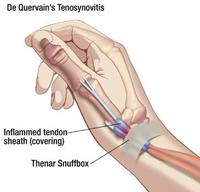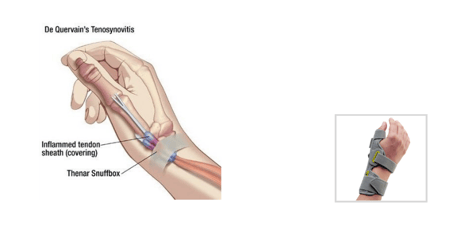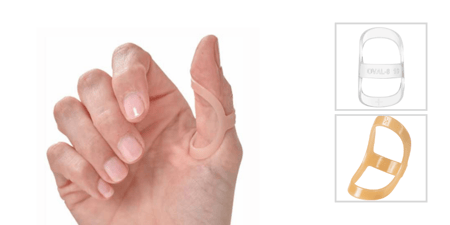 De Quervain’s Tenosynovitis can make even simple daily tasks—like lifting a cup or typing—painful and frustrating. Patients often present with pain and swelling on the radial side of the wrist, which may radiate up the thumb or forearm. The discomfort typically worsens with activities involving thumb abduction or flexion. While the condition is often linked to overuse or repetitive motions, it can also occur without a clear cause.
De Quervain’s Tenosynovitis can make even simple daily tasks—like lifting a cup or typing—painful and frustrating. Patients often present with pain and swelling on the radial side of the wrist, which may radiate up the thumb or forearm. The discomfort typically worsens with activities involving thumb abduction or flexion. While the condition is often linked to overuse or repetitive motions, it can also occur without a clear cause.
Recognizing the Symptoms of de Quervain’s
Common signs of De Quervain’s include:
- Radial-sided wrist pain with or without inflammation at the base of the thumb
- Pain with thumb abduction or flexion
- Tenderness or inflammation along the thumb side of the wrist
- A snapping or catching sensation when moving the thumb
- Possible numbness on the back of the thumb, sometimes extending to the index finger
|
For patients or consumer-ready thumb braces, visit our sister site- shopoma.com |
Treatment Options
Because De Quervain’s is a tendinopathy, physical and occupational therapy are often effective first-line treatments. Typical interventions may include:
- Nonsteroidal anti-inflammatory agents (NSAIDs)
- Cryotherapy or ultrasound with topical corticosteroids
- Iontophoresis to reduce inflammation and pain.
The Role of Splinting
Splinting is widely recommended as an initial conservative treatment. The goal is to limit painful thumb and wrist motions while allowing functional hand use.
Depending on the severity and duration of symptoms, splints may vary in design and rigidity:
- Soft, flexible supports for mild or intermittent symptoms
- Moderately restrictive splints for persistent pain
- Firm, immobilizing splints for chronic or severe cases
Recommended Solution: 3pp Ez FIT Thumb Spica Splint
The 3pp Ez FIT Thumb Spica Splint provides targeted support for patients managing De Quervain’s symptoms. Its full-length, adjustable aluminum stay can be contoured for precise positioning of the thumb and wrist, helping to reduce stress on the affected tendons.
Key features include:
- Open-palm design for improved hand function and compliance
- Lightweight, breathable materials for all-day comfort
- Custom contouring to ensure optimal alignment and stabilization
Follow-Up Care
Monitor patients regularly to ensure proper splint fit and compliance. If symptoms persist despite full-time splint wear and conservative management, consider further evaluation or referral for possible corticosteroid injection or surgical release.
Patients and Consumers
Interested in learning more about de Quervain’s (also known as Mommy’s Thumb)?









